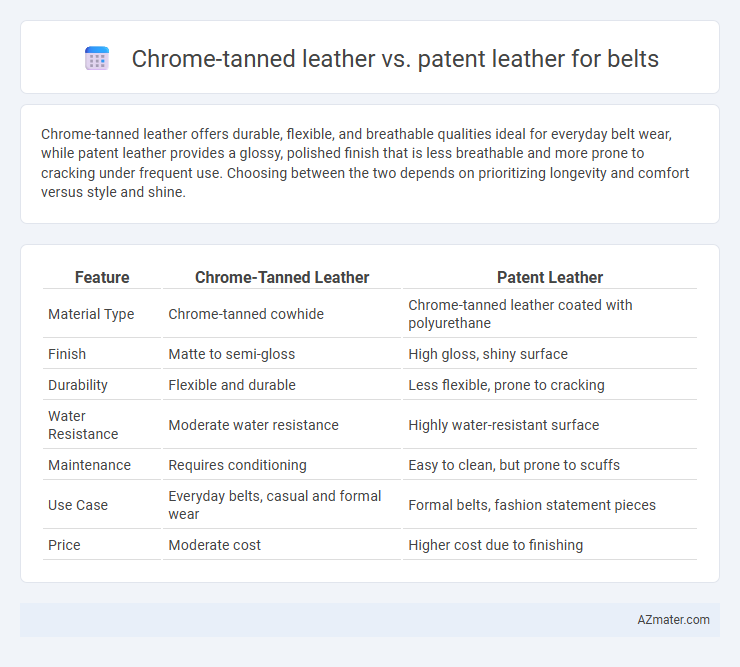Chrome-tanned leather offers durable, flexible, and breathable qualities ideal for everyday belt wear, while patent leather provides a glossy, polished finish that is less breathable and more prone to cracking under frequent use. Choosing between the two depends on prioritizing longevity and comfort versus style and shine.
Table of Comparison
| Feature | Chrome-Tanned Leather | Patent Leather |
|---|---|---|
| Material Type | Chrome-tanned cowhide | Chrome-tanned leather coated with polyurethane |
| Finish | Matte to semi-gloss | High gloss, shiny surface |
| Durability | Flexible and durable | Less flexible, prone to cracking |
| Water Resistance | Moderate water resistance | Highly water-resistant surface |
| Maintenance | Requires conditioning | Easy to clean, but prone to scuffs |
| Use Case | Everyday belts, casual and formal wear | Formal belts, fashion statement pieces |
| Price | Moderate cost | Higher cost due to finishing |
Introduction to Chrome-Tanned and Patent Leather
Chrome-tanned leather is produced using chromium salts, resulting in a supple, durable material with excellent resistance to water and stains, ideal for everyday belts. Patent leather features a high-gloss, shiny finish achieved through a lacquer coating, offering a stylish and formal appearance but requiring more care to prevent cracking or peeling. Both types provide unique aesthetics and functional benefits, with chrome-tanned leather favoring durability and patent leather emphasizing polished elegance.
What is Chrome-Tanned Leather?
Chrome-tanned leather is processed using chromium salts, which speeds up tanning and produces a soft, durable, and water-resistant material ideal for belts. This method enhances the leather's flexibility and color retention compared to traditional vegetable tanning, offering a smoother finish for everyday wear. Chrome-tanned leather belts typically exhibit superior resistance to heat and moisture, making them practical and long-lasting wardrobe accessories.
What is Patent Leather?
Patent leather is a type of leather coated with a high-gloss synthetic finish that gives it a shiny, mirror-like appearance ideal for formal accessories like belts. Chrome-tanned leather, by comparison, undergoes a chemical tanning process using chromium salts, resulting in more flexible and durable leather with a natural look. Patent leather offers a sleek, polished aesthetic with water-resistant properties, while chrome-tanned leather emphasizes comfort and long-lasting wear.
Production Processes Compared
Chrome-tanned leather undergoes a chemical tanning process using chromium salts, which significantly reduces tanning time to a few days and results in a soft, durable material with excellent water resistance ideal for belts. Patent leather is produced by applying a high-gloss lacquer or synthetic coating to chromium-tanned leather, providing a shiny, smooth finish that enhances aesthetic appeal but requires additional drying and polishing steps. The production of patent leather involves more complex finishing procedures compared to the straightforward chrome tanning, impacting both texture and maintenance requirements of the final belt product.
Durability: Chrome-Tanned vs Patent Leather
Chrome-tanned leather offers superior durability for belts due to its flexible and strong fiber structure, resisting cracking and wear over time. Patent leather, coated with a glossy finish, tends to be less durable as the surface layer can scuff or peel, especially with frequent bending. For long-lasting belts, chrome-tanned leather maintains structural integrity better under daily use and environmental exposure.
Appearance and Finish Differences
Chrome-tanned leather features a supple, matte finish with natural grain texture that softens over time, offering a more understated and versatile aesthetic for belts. Patent leather is characterized by its high-gloss, mirror-like surface achieved through a plastic coating, delivering a polished and formal look ideal for dressier occasions. The distinct appearance and finish of chrome-tanned leather provide durability with subtle elegance, while patent leather emphasizes shine and a sleek, eye-catching style.
Comfort and Flexibility
Chrome-tanned leather offers superior comfort and flexibility for belts due to its soft, supple texture and resistance to stiffness, allowing it to mold easily to the wearer's body over time. Patent leather, with its glossy, coated finish, tends to be less flexible and can feel stiffer, making it less comfortable for prolonged wear. The chrome-tanning process preserves the natural breathability and pliability of the leather, enhancing overall comfort in belt applications.
Maintenance and Care Requirements
Chrome-tanned leather belts require regular cleaning with a damp cloth and occasional conditioning to maintain their softness and prevent drying or cracking. Patent leather belts demand careful wiping with a soft, damp cloth to preserve their glossy finish and avoid scratches, while avoiding harsh chemicals that can damage the surface. Both types benefit from proper storage away from direct sunlight and moisture to extend their lifespan.
Cost Analysis: Chrome-Tanned vs Patent Leather Belts
Chrome-tanned leather belts typically cost less due to faster tanning processes and lower material expenses, making them a budget-friendly option for everyday use. Patent leather belts, featuring a glossy finish achieved through additional coatings and treatments, generally incur higher production costs, resulting in premium pricing. Consumers seeking durability and affordability often favor chrome-tanned belts, while those valuing aesthetic appeal and luxury are inclined toward pricier patent leather belts.
Best Uses and Recommendations
Chrome-tanned leather offers superior durability and flexibility, making it ideal for everyday belts that require comfort and resistance to wear and water. Patent leather, characterized by its glossy finish and sophisticated appearance, is best suited for formal occasions and stylish accessories where aesthetics take precedence over ruggedness. For long-lasting daily use, chrome-tanned belts provide practical benefits, while patent leather belts excel in enhancing formal attire with their sleek, polished look.

Infographic: Chrome-tanned leather vs Patent leather for Belt
 azmater.com
azmater.com